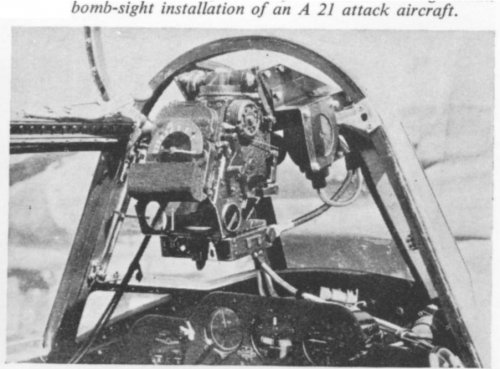Dive-bombing became my greatest interest from 1940 onwards. As a matter of fact we had a flying test model of our equipment as soon as nine months after the original idea, i.e. we flew and made test bombing in August 1940. From late 1942 all aircraft from Saab were equipped. It is true that we were very isolated from foreign developments in dive-bombing, not only during the hostilities but for a long period after 1945.
A period of experimenting began in summer 1940, with the definite object of building a trial model of the bombing instrument. In a small laboratory which had been equipped for the purpose, we studied the possibilities of carrying out the various suggestions for the solution of the technical detail problems, and under Mr Faxén, the designing of the trial instruments began.
Many difficulties were encountered. The rapid change of altitude and speed in the dive made great demands on the immediate reaction of the instrument. Various causes for time delays were therefore carefully studied, but only after producing a few interesting inventions of details did we obtain the basic conditions for achieving accuracy in spite of temperature changes, vibrations and external acceleration.
From the outset the air tests proved that the fundamental idea was correct, namely, that the pilot could accurately and easily direct his aircraft towards the target in a medium-steep dive and that the pull-out from the dive could be made in the calculated manner. Until these preliminary tests had been made, it was of course impossible to determine whether this bombing method would be practicable. The functioning of the trial instrument was first checked by electric measuring devices and lamps, which registered the bomb-release during pull-out. When the results appeared favourable, the first releases of practice bombs were begun. The results showed well-concentrated hits, which promised well for the future.
[...]
An attack according to the new method would be as follows. The pilot dives the aeroplane straight toward the target, aiming by means of a fixed sight approximately in alignment with the direction of flight. He presses a button and begins the pull-out, i.e. recovery from the dive. An automatic instrument measures the various factors influencing the proper release and gives the impulse, which releases the bomb at just that moment in the pull-out when the aircraft attains the correct attitude for release. The pilot is the only person concerned in the process and it is easy for him to align the sight because it is approximately in the direction of flight toward the target, and then to end the dive with a sufficiently correct pull-out. The instrument can be designed to cope with wide variations of dive angle, height of release, speed, etc., which also facilitates operation for the pilot. The possibility of variation in the choice of elements of air is also advantageous from the point of view of tactics, as is also the fact that the time required for aiming can be very short, can be preceded by evasive manoeuvres, and is also automatically followed by an evasive movement, the pull-out.
The curvature of the bomb trajectory is compensated by the change of direction of motion of the aircraft during the pull-out. The pilot's view forwards and downwards, which is very often limited by the structure of the aeroplane, does not need to be utilised for a movable sight line, and the pilot accordingly has a good field of view round all sides of the target at the moment of attack.


